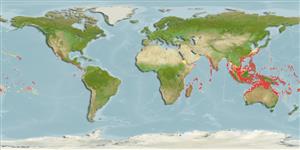Common names from other countries
>
Aulopiformes (Grinners) >
Synodontidae (Lizardfishes) > Synodontinae
Etymology: Synodus: Greek, syn, symphysis = grown together + Greek, odous = teeth (Ref. 45335); jaculum: jaculum (neuter noun in apposition) from the Latin word for javelin, in reference to the peculiar behavior of this species of launching itself off the bottom and swimming in midwater for prolonged periods..
Environment: milieu / climate zone / depth range / distribution range
Ecología
marino asociado a arrecife; rango de profundidad 2 - 100 m (Ref. 11228). Tropical; 33°N - 32°S
Indo-Pacific: East Africa to the Line, Marquesan, and Society islands, north to the Izu Islands (Japan), south to New South Wales (Australia); Palau to Kosrae in Micronesia.
Tamaño / Peso / Age
Maturity: Lm ? range ? - ? cm
Max length : 20.0 cm TL macho / no sexado; (Ref. 2334); common length : 10.0 cm TL macho / no sexado; (Ref. 3520)
Espinas dorsales (total) : 0; Radios blandos dorsales (total) : 11 - 13; Espinas anales: 0; Radios blandos anales: 8 - 10. Body brownish above, with dark brown saddle blotches; fins transparent, with faint brown spots on dorsal and caudal rays (Ref. 11228). Prominent black blotch on its caudal peduncle (Ref. 1602).
Inhabits coral reefs. Commonly found on sand or rubble near coral heads. Feeds on shrimps and small fishes (Ref. 89972). Frequently caught with S. variegatus and S. englemani, using artisanal gear and trawls. Sold fresh and dried salted in markets. Solitary,in pairs or in small groups (Ref 90102).
Life cycle and mating behavior
Maturities | Reproducción | Spawnings | Egg(s) | Fecundities | Larva
Cressey, R.F. and R.S. Waples, 1984. Synodontidae. In W. Fischer and G. Bianchi (eds.) FAO species identification sheets for fishery purposes. Western Indian Ocean (Fishing Area 51). Volume 4. FAO, Rome. (Ref. 3520)
IUCN Red List Status (Ref. 130435)
CITES (Ref. 128078)
Not Evaluated
Threat to humans
Harmless
Human uses
Pesquerías: escaso valor comercial
Herramientas
Special reports
Download XML
Fuentes de Internet
Estimates based on models
Preferred temperature (Ref.
115969): 24.5 - 29, mean 27.9 (based on 1488 cells).
Phylogenetic diversity index (Ref.
82804): PD
50 = 0.5000 [Uniqueness, from 0.5 = low to 2.0 = high].
Bayesian length-weight: a=0.00447 (0.00211 - 0.00945), b=3.16 (2.99 - 3.33), in cm Total Length, based on LWR estimates for this Genus-body shape (Ref.
93245).
Nivel trófico (Ref.
69278): 4.0 ±0.7 se; based on size and trophs of closest relatives
Resiliencia (Ref.
120179): Alto, población duplicada en un tiempo mínimo inferior a 15 meses (Preliminary K or Fecundity.).
Fishing Vulnerability (Ref.
59153): Low vulnerability (10 of 100).
